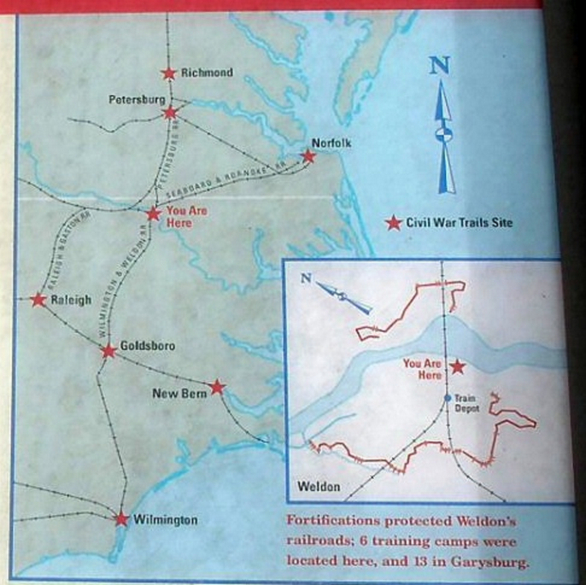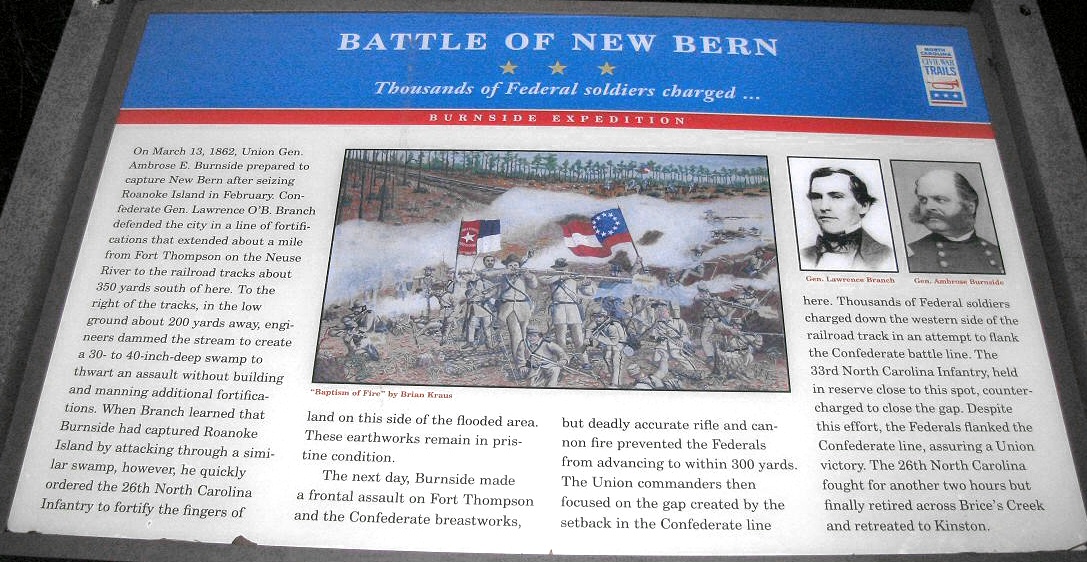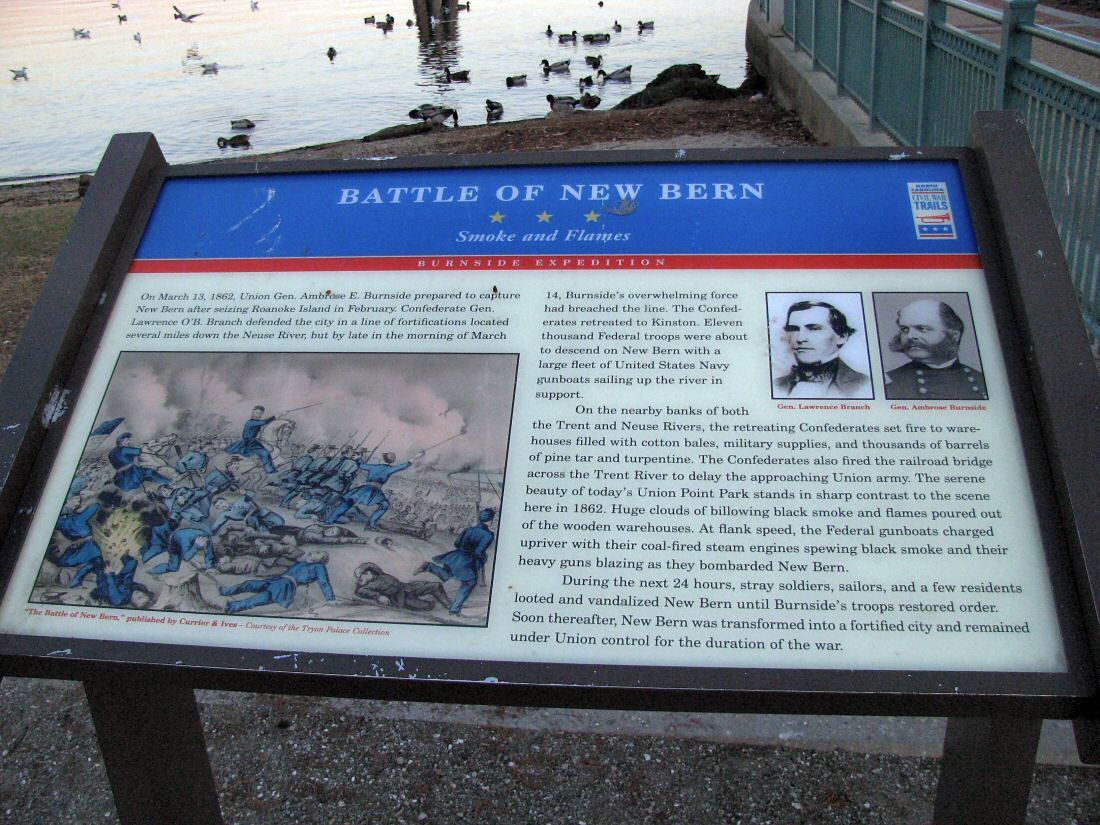|
Battle of New Bern : Fall of New Bern
Occupation of the City of New Bern (spelled New Berne at the time) by
Union troops essentially cut off rail and naval supply lines to the North, isolating the Confederate Army of Virginia.
| Forts protecting Wilmington Weldon Railroad Map |

|
| Strategically Important North Carolina Civil War Railroad |
Founded in 1710, New Bern, North Carolina, is the second-oldest city in
the state, founded by German and Swiss adventurers. Prior to the American Revolution, Royal Gov. William Tryon made this seaport
his colonial capitol and commissioned the construction of Tryon
Palace in 1770.
By August 1861, the Union army had secured the Pamlico Sound inlets after defeating the Confederate forces and capturing Forts Clark and Hatteras. By winter 1862, Gen. A. E. Burnside and Commodore L. M. Goldsborough had
seized the Confederate positions on Roanoke Island and New Berne (as it was originally spelled). Union control of the inner coastal
position tightened the blockade of the North Carolina coast, but the state didn't capitulate
until April 26, 1865, when Gen. Joseph Johnston surrendered the last major Confederate army to Gen. William T. Sherman near
Durham, North Carolina.
| Civil War Battle of New Bern, North Carolina |

|
| Battle of New Bern, North Carolina |
The
Battle of New Berne, as it was known then, was fought on March 14, 1862, near the city of New Bern, as
part of Burnside's North Carolina Expedition. On March 11, Brigadier General Ambrose Burnside’s command launched from
Roanoke Island to rendezvous with Union gunboats at Hatteras Inlet for an attack on New Bern. The defending Confederate
commander was Brigadier General Lawrence Branch. On March 13, the fleet progressed the
Neuse River
and disembarked on the river's south bank only a few miles from the city's defenses.
On March 14, three brigades under
John G. Foster, Jesse L. Reno and John G. Parke attacked along the railroad and drove the Confederates out of their fortifications.
The Federals captured nine forts and 41 heavy guns, and despite several Confederate attempts to retake the town, it remained
a Union occupied base until the end of the war. The ensuing occupation of the City of New
Bern essentially cut off rail and naval supply lines to the North, isolating the Confederate Army of
Virginia.
| Battle of New Bern, NC |

|
| Battle of New Bern History |
New Bern National Cemetery was
officially established Feb. 1, 1867, and many of the burials at New Bern are reinterments of remains from the surrounding
area, including Beaufort, Hatteras and locations along the coast. Over 1,000 unknowns are buried in a separate section. New
Bern National Cemetery was listed on the National Register of Historic Places in 1997.
Sources: National Park Service; Fort Raleigh National Historic Site; Official Records of
the Union and Confederate Armies; U.S. Department of Veterans Affairs; North
Carolina Civil War Tourism Council, Inc; New Bern Historical Society; North Carolina Museum of History.
Recommended Reading: The Civil War in the Carolinas
(Hardcover). Description: Dan Morrill relates the experience
of two quite different states bound together in the defense of the Confederacy, using letters, diaries, memoirs, and reports.
He shows how the innovative operations of the Union army and navy along the coast and
in the bays and rivers of the Carolinas affected the general course of the war as well as
the daily lives of all Carolinians. He demonstrates the "total war" for North
Carolina's vital coastal railroads and ports. In the latter part of the war, he describes
how Sherman's operation cut out the heart of the last stronghold
of the South. Continued below...
The author
offers fascinating sketches of major and minor personalities, including the new president and state governors, Generals Lee,
Beauregard, Pickett, Sherman, D.H. Hill, and Joseph E. Johnston. Rebels and abolitionists, pacifists and unionists, slaves
and freed men and women, all influential, all placed in their context with clear-eyed precision. If he were wielding a needle
instead of a pen, his tapestry would offer us a complete picture of a people at war. Midwest Book Review: The Civil War in the Carolinas by civil war expert and historian
Dan Morrill (History Department, University of North Carolina at Charlotte, and Director of the Charlotte-Mecklenburg Historical
Society) is a dramatically presented and extensively researched survey and analysis of the impact the American Civil War had
upon the states of North Carolina and South Carolina, and the people who called these states their home. A meticulous, scholarly,
and thoroughly engaging examination of the details of history and the sweeping change that the war wrought for everyone, The
Civil War In The Carolinas is a welcome and informative addition to American Civil War Studies reference collections.
Advance to:
Recommended Reading: Ironclads and Columbiads: The Coast (The Civil War in North Carolina)
(456 pages). Description: Ironclads and Columbiads
covers some of the most important battles and campaigns in the state. In January 1862, Union forces began in earnest to occupy
crucial points on the North Carolina coast. Within six months,
Union army and naval forces effectively controlled coastal North Carolina from the Virginia line south to present-day Morehead
City. Union setbacks in Virginia, however, led to the withdrawal of many
federal soldiers from North Carolina, leaving only enough Union troops to hold a few coastal strongholds—the vital ports
and railroad junctions. The South during the Civil War, moreover, hotly contested the North’s ability to maintain its
grip on these key coastal strongholds.
Recommended Reading: The
Civil War on the Outer Banks: A History of the Late Rebellion Along the Coast of North Carolina from Carteret to Currituck
With Comments on Prewar Conditions and an Account of (251 pages). Description: The ports at Beaufort, Wilmington, New Bern and Ocracoke, part of the Outer Banks (a chain
of barrier islands that sweeps down the North Carolina coast from the Virginia Capes to Oregon Inlet), were strategically
vital for the import of war materiel and the export of cash producing crops. From official records, contemporary newspaper
accounts, personal journals of the soldiers, and many unpublished manuscripts and memoirs, this
is a full accounting of the Civil War along the North Carolina
coast.
Recommended Reading:
The Civil War in Coastal North Carolina (175 pages) (North Carolina Division
of Archives and History). Description: From the drama
of blockade-running to graphic descriptions of battles on the state's islands and sounds, this book portrays the explosive
events that took place in North Carolina's coastal region during the Civil War. Topics discussed include the strategic
importance of coastal North Carolina, Federal occupation
of coastal areas, blockade-running, and the impact of war on civilians along the Tar Heel coast.
Recommended Reading: Storm
over Carolina: The Confederate Navy's Struggle for Eastern North Carolina. Description: The struggle for control of the eastern
waters of North Carolina during the War Between the States
was a bitter, painful, and sometimes humiliating one for the Confederate navy. No better example exists of the classic adage,
"Too little, too late." Burdened by the lack of adequate warships, construction facilities, and even ammunition, the
South's naval arm fought bravely and even recklessly to stem the tide of the Federal invasion of North
Carolina from the raging Atlantic. Storm
Over Carolina is the account of the Southern navy's struggle in North
Carolina waters and it is a saga of crushing defeats interspersed with moments of brilliant and even
spectacular victories. It is also the story of dogged Southern determination and incredible perseverance in the face
of overwhelming odds. Continued below...
For most of
the Civil War, the navigable portions of the Roanoke, Tar, Neuse, Chowan, and Pasquotank rivers were
occupied by Federal forces. The Albemarle and Pamlico sounds, as well as most of the coastal towns and counties, were also
under Union control. With the building of the river ironclads, the Confederate navy at last could strike a telling blow against
the invaders, but they were slowly overtaken by events elsewhere. With the war grinding to a close, the last Confederate vessel
in North Carolina waters was destroyed. William T. Sherman
was approaching from the south, Wilmington was lost, and the
Confederacy reeled as if from a mortal blow. For the Confederate navy, and even more so for the besieged citizens of eastern
North Carolina, these were stormy days indeed. Storm Over Carolina describes their story, their struggle, their history.
|

